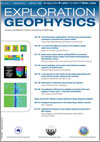
Exploration Geophysics
Volume 44 Number 3 2013
Featuring papers from the 2011 Western Australia Geothermal Energy Symposium (WAGES)
EG13026Three-dimensional magnetotelluric inversion using a heterogeneous smoothness-constrained least-squares method
This paper presents a fast magnetotelluric inversion algorithm which is distinctive for the level of accuracy it attains while bypassing the sensitivity matrix update. It updates the smoothness filter coefficients at each model element. Using synthetic examples, we demonstrate that the method can bypass the sensitivity matrix update.
EG12064A 21-point finite difference scheme for 2D frequency-domain elastic wave modelling
This paper presents a 21-point finite difference (FD) scheme for the frequency-space domain elastic wave forward modelling, which is about 15% lower in memory consumption and computing time than the 25-point scheme. The numerical examples show that the 21-point FD scheme is valid in the sense of the numerical simulation of ideal models.
EG13049Using reverse vertical seismic profiling (RVSP) to characterise the subsurface fracture system of the Seokmo Island geothermal field, Republic of Korea
This paper presents a case study of fracture-system interpretation using reverse vertical seismic profiling (RVSP) with seismic reflection, and borehole televiewer data on Seokmo Island, South Korea. Using the proposed method and integration with other data, we substantially improved our understanding of the subsurface structure, including fractures beneath the geothermal site.
EG12032Forward modelling and inversion of self-potential anomalies caused by 2D inclined sheets
Self-potential (SP) anomalies observed over sulfide ore bodies can be closely associated with electrochemical reactions and the ohmic potential drop within the rocks. In this study, two sheets of zinc and copper were joined together to simulate sheet-like ore bodies. SP surveys were conducted with the purpose of revealing the influence of various angles of the sheet.
EG12045A new approach to semi-infinite thin slab depth determination from second moving average residual gravity anomalies
In this paper, a new and efficient method to determine the depth of a buried faulted structure from gravity data is presented. A fault model, convolved with the same second moving average filter, is fitted to observed data in a least-squares error sense. The method is applied to theoretical and field data.
EG12030Optimisation of temperature observational well selection
For deep wells (>100–300 m), the drilling process greatly alters the temperature of formation immediately surrounding the well. In this paper, we suggest two techniques, Slider’s method and γ-function utilisation, which enable us to estimate the rate of temperature decline and the difference between the formation and shut-in temperatures.
EG12068The application of Monte Carlo modelling to downhole total-count logging of uranium: part II – high grade mineralisation
A new method is proposed to convert gamma-ray log data to in situ uranium estimates, which is especially applicable to high grades (>2 %). Monte Carlo modelling is utilised to derive the necessary environment corrections, which is demonstrated on log data from two deposits and a variety of probes.
EG13028Radiogenic heat generation in the Darling Range, Western Australia
New heat generation measurements for granites were made for the Darling Range, Western Australia. The heat generation in the granites was determined from concentrations of uranium, thorium and potassium measured in the field. Heat generation in the Darling Range localities varied between 4 and 10 μW/m3.
EG13036Geophysical techniques for low enthalpy geothermal exploration in New Zealand
This paper presents representative case studies of the geophysical explorations for low enthalpy geothermal resources in New Zealand using shallow temperature measurements, the gravity method, DC resistivity measurements, and electromagnetic (EM) surveys. It discusses the successes and failures of the different geophysical methods in recognising and delineating the low enthalpy resources in a variety of geological settings.

